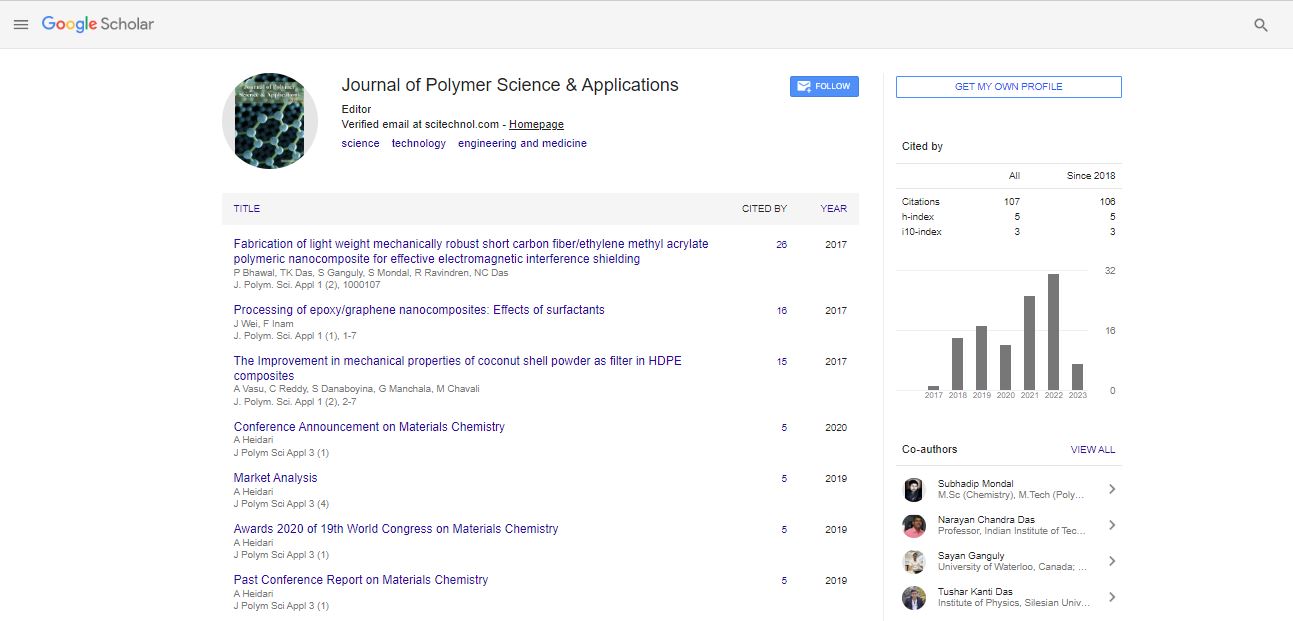Perspective, J Polym Sci Appl Vol: 7 Issue: 2
Polymer Processing: The process of Raw Materials to End Products
Gracia Issi*
Department of Chemical Sciences, University of Padova, Padova, Italy
*Corresponding Author: Gracia Issi
Department of Chemical Sciences
University of Padova, Padova, Italy
E-mail: issigracia@gmail.com
Received date: 15 May, 2023, Manuscript No. JPSA-23-106514;
Editor assigned date: 17 May, 2023, PreQC No. JPSA-23-106514 (PQ);
Reviewed date: 01 June, 2023, QC No. JPSA-23-106514;
Revised date: 08 June, 2023, Manuscript No. JPSA-23-106514 (R);
Published date: 16 June, 2023, DOI: 10.4172/Jpsa.1000141
Citation: Issi G (2023) Polymer Processing: The process of Raw Materials to End Products. J Polym Sci Appl 7:2.
Description
Polymer processing is a major step in the manufacturing of a wide range of products used in our daily lives. It involves transforming raw polymer materials into finished products through various techniques. Polymer processing encompasses a series of steps, including compounding, shaping, and finishing, that allow manufacturers to mold, extrude, or cast polymers into desired forms.
Raw material selection
The first step in polymer processing is the careful selection of raw materials. Polymer manufacturers consider factors such as desired properties, end-use requirements, and cost when choosing the appropriate polymer for a specific application. Factors like polymer type (e.g., polyethylene, polystyrene), molecular weight, and additives (e.g., fillers, plasticizers) are taken into account to achieve the desired characteristics in the final product.
Compounding
Compounding involves blending the selected polymers with additives and fillers to achieve desired properties or enhance performance. This step can be performed through various methods, including melt compounding, solution compounding, or solid-state blending. During compounding, the polymer is mixed with additives such as stabilizers, colorants, flame retardants, or reinforcing agents to improve the polymer's properties or tailor it for specific applications.
Shaping techniques
Shaping is a difficult step in polymer processing, where the compounded polymer is transformed into the desired form. Common shaping techniques include injection molding, extrusion, blow molding, and rotational molding.
Injection molding involves injecting molten polymer into a mold cavity under high pressure, allowing it to cool and solidify. It is widely used for producing complex-shaped objects, such as automotive parts, containers, and consumer goods. Extrusion is a continuous process where the polymer is melted and forced through a die to produce a long, uniform shape. It is commonly used for manufacturing plastic pipes, profiles, films, and sheets.
Blow molding is used to process hollow objects, such as bottles or containers. The process involves inflating a heated polymer tube in a mold, allowing it to take the desired shape. Rotational molding involves rotating a hollow mold filled with polymer powder or liquid around multiple axes, allowing the polymer to coat the mold surface and form the desired shape. It is suitable for producing large, complexshaped objects, such as storage tanks and playground equipment.
Finishing processes
After shaping, the polymer product may undergo additional finishing processes to improve its appearance, functionality, or performance. Finishing processes can include surface treatments (e.g., polishing, coating), machining, assembly, or quality control inspections to ensure the product meets the desired specifications.
Conclusion
Polymer processing is a multifaceted journey that transforms raw polymer materials into finished products we use in various industries. Starting with the careful selection of raw materials, manufacturers utilize compounding techniques to modify and enhance polymer properties. Shaping techniques, such as injection molding, extrusion, blow molding, or rotational molding, allow for the creation of complex shapes and forms. Finally, finishing processes add the final touches to the product, ensuring it meets the required specifications. Polymer processing plays a vital role in manufacturing a wide range of products, from packaging materials and automotive components to medical devices and consumer goods, shaping the modern world we live in.
 Spanish
Spanish  Chinese
Chinese  Russian
Russian  German
German  French
French  Japanese
Japanese  Portuguese
Portuguese  Hindi
Hindi 